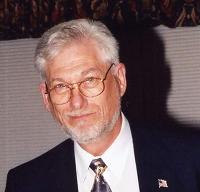Klaus J. Schulz 2003 Goldich Medal Recipient
Klaus Schulz has had a long and productive career spanning more than 30 years as a geologist in the Lake Superior region. He was introduced to the geology through his education in the area, he completed graduate studies in the region, performed several summers of field work for mining companies in a number of different areas, and has conducted extensive research as a scientist with the U.S. Geological Survey. This extensive and diverse experience has made him a real authority on the geology of the Lake Superior region.

In the summer of 1971, Klaus and William Spence discovered the Lake Ellen kimberlite near Crystal Falls, Michigan, while working as exploration geologists in the area. Klaus was very much involved in the recognition of the rock as a kimberlite. This was the first kimberlite discovered in the Lake Superior region.
His Masters thesis involved considerable mapping in the Ely greenstone belt in Minnesota, and geochemical studies for his Ph.D. dissertation showed that the Newton Lake Formation was a high-magnesium basalt, similar to komatiites. This was the first documented occurrence of komatiitic rocks in the Lake Superior region.
In the early 1980s, his field mapping and geochemistry of rocks in the Pembine area of the Wisconsin magmatic terranes demonstrated the presence of ophiolitic rocks. Again, this was the first documented ophiolite in the Lake Superior region, and showed that the Wisconsin magmatic terranes were, at least in part, an oceanic island arc. His subsequent model for the evolution of the Marquette Range Supergoup on the continental margin during the Penokean orogeny is an extension of his familiarity 'with the rocks in the region combined with his encyclopedic knowledge of the geologic literature on the evolution of continental margins.
Klaus also contributed to the GLIMPCE program, which ultimately provided significant insight into the structure and origin of the Mid-continent rift, and into its magmatic origin and metallogeny.
He has authored and co-authored more than 120 publications, maps, abstracts and field guides, including field guides for the 1984, 1992, and 2003 Institute meetings.
Klaus' contributions have provided a better understanding of the Archean, the Early Proterozoic, the Middle Proterozoic, and the Phanerozoic history of the Lake Superior region. And he continues to be an active contributor on a global stage, taking the knowledge and experience that he has gained in the Lake Superior region and applying it to international projects.
Therefore, it is my distinct pleasure and honor to present Klaus Juergen Schulz as the 2003 recipient of the Goldich Medal "For Outstanding Contributions To The Lake Superior Region."
Submitted by Gene L. LaBerge
Awarded May 7, 2003
Iron Mountain, Michigan
49th Annual Institute on Lake Superior Geology